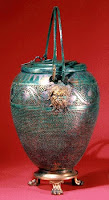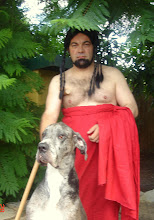I'd like to introduce you to my new friends from far away - well far away from Australia:
Anabasis -
 First we have Andrew ( Andrey Lovchikov ) from "Anabasis" a new club in St Petersburg. They have just started a new Live Journal page . Their focus is the Bosporan Greek Kingdoms. From a practical perspective costume and arms will suit their weather pattern. So adaption of Scythian clothing will not go astray. Their difficulty will be to document what they are doing. They have access to their museums and archaeological reports and numismatics but as the literary record is pretty sparse they would love to hear from you if you have new information. The page is in Russian but they are going to add English translations of Russian articles. (I use the Google translator myself.) You can contact Anabasis by leaving a comment on their Live Journal page or by emailing Andrew: anabasisclub@mail.ru
First we have Andrew ( Andrey Lovchikov ) from "Anabasis" a new club in St Petersburg. They have just started a new Live Journal page . Their focus is the Bosporan Greek Kingdoms. From a practical perspective costume and arms will suit their weather pattern. So adaption of Scythian clothing will not go astray. Their difficulty will be to document what they are doing. They have access to their museums and archaeological reports and numismatics but as the literary record is pretty sparse they would love to hear from you if you have new information. The page is in Russian but they are going to add English translations of Russian articles. (I use the Google translator myself.) You can contact Anabasis by leaving a comment on their Live Journal page or by emailing Andrew: anabasisclub@mail.ru Sardinian Warrior -
 Talk about exotic and eclectic! Sardinian Warrior is the creation of Alessandro Lessa. You’ll need to switch on your Italian translator – especially if you want to wander off and explore his other blogs and links. The first settlers on Sardinia were the enigmatic Nurag people of the Bronze Age, famous for their beehive live structures that are very like tholos tombs. Not much is known about the Nuraghi except that they did achieve a level of sophistication that included sea trade. Both the Nurag people and the short lived Greek colonies on Sardinia's coast were annexed by Carthage in 537 BC. Lessa is putting together his hoplite kit as we speak but a visit to his blog will take you on a journey through the byways of Sardinia’s extraordinary history.
Talk about exotic and eclectic! Sardinian Warrior is the creation of Alessandro Lessa. You’ll need to switch on your Italian translator – especially if you want to wander off and explore his other blogs and links. The first settlers on Sardinia were the enigmatic Nurag people of the Bronze Age, famous for their beehive live structures that are very like tholos tombs. Not much is known about the Nuraghi except that they did achieve a level of sophistication that included sea trade. Both the Nurag people and the short lived Greek colonies on Sardinia's coast were annexed by Carthage in 537 BC. Lessa is putting together his hoplite kit as we speak but a visit to his blog will take you on a journey through the byways of Sardinia’s extraordinary history.Ports of Call
 Herodotus on the Web is a site by Tim Spalding. It is a guide and web directory to Herodotus of Halicarnassus, the famous Greek historian. On this site you will find over 200 links to resources about Herodotus and his age. These includes texts and translations, books about Herodotus, essays and articles, and so forth. He has attempted (sucessfully in my opinion) to organize these resources well, describe their contents and evaluate their readability and value as scholarship.
Herodotus on the Web is a site by Tim Spalding. It is a guide and web directory to Herodotus of Halicarnassus, the famous Greek historian. On this site you will find over 200 links to resources about Herodotus and his age. These includes texts and translations, books about Herodotus, essays and articles, and so forth. He has attempted (sucessfully in my opinion) to organize these resources well, describe their contents and evaluate their readability and value as scholarship.
 Diotima serves as an interdisciplinary resource for anyone interested in patterns of gender around the ancient Mediterranean and as a forum for collaboration among instructors who teach courses about women and gender in the ancient world. This site includes course materials, the beginnings of a systematic and searchable bibliography, and links to many on-line resources, including articles, book reviews, databases, and images. Ross Scaife and Suzanne Bonefas launched this project in early 1995; since that time it has been developed with help and contributions from many quarters.
Diotima serves as an interdisciplinary resource for anyone interested in patterns of gender around the ancient Mediterranean and as a forum for collaboration among instructors who teach courses about women and gender in the ancient world. This site includes course materials, the beginnings of a systematic and searchable bibliography, and links to many on-line resources, including articles, book reviews, databases, and images. Ross Scaife and Suzanne Bonefas launched this project in early 1995; since that time it has been developed with help and contributions from many quarters.
 Perseus Digital Library Project Since planning began in 1985, the Perseus Digital Library Project has explored what happens when libraries move online. Two decades later, as new forms of publication emerge and millions of books become digital, this question is more pressing than ever. Perseus is a practical experiment in which explores possibilities and challenges of digital collections in a networked world. Perseus maintains a web site that showcases collections and services developed as a part of our research efforts over the years. The code for the digital library system and many of the collections that we have developed are now available.
Perseus Digital Library Project Since planning began in 1985, the Perseus Digital Library Project has explored what happens when libraries move online. Two decades later, as new forms of publication emerge and millions of books become digital, this question is more pressing than ever. Perseus is a practical experiment in which explores possibilities and challenges of digital collections in a networked world. Perseus maintains a web site that showcases collections and services developed as a part of our research efforts over the years. The code for the digital library system and many of the collections that we have developed are now available.
 The virtual Museum of Ancient Inventions is a minor subject of the History of Science and Technology at Smith College, a project begun by the students in the course Ancient Inventions, which was offered for the first time in the spring semester of 1997. More inventions will be acquired by the museum each year that the course is offered. Not all are from ancient Hellas but many are.
The virtual Museum of Ancient Inventions is a minor subject of the History of Science and Technology at Smith College, a project begun by the students in the course Ancient Inventions, which was offered for the first time in the spring semester of 1997. More inventions will be acquired by the museum each year that the course is offered. Not all are from ancient Hellas but many are.
 First we have Andrew ( Andrey Lovchikov ) from "Anabasis" a new club in St Petersburg. They have just started a new Live Journal page . Their focus is the Bosporan Greek Kingdoms. From a practical perspective costume and arms will suit their weather pattern. So adaption of Scythian clothing will not go astray. Their difficulty will be to document what they are doing. They have access to their museums and archaeological reports and numismatics but as the literary record is pretty sparse they would love to hear from you if you have new information. The page is in Russian but they are going to add English translations of Russian articles. (I use the Google translator myself.) You can contact Anabasis by leaving a comment on their Live Journal page or by emailing Andrew: anabasisclub@mail.ru
First we have Andrew ( Andrey Lovchikov ) from "Anabasis" a new club in St Petersburg. They have just started a new Live Journal page . Their focus is the Bosporan Greek Kingdoms. From a practical perspective costume and arms will suit their weather pattern. So adaption of Scythian clothing will not go astray. Their difficulty will be to document what they are doing. They have access to their museums and archaeological reports and numismatics but as the literary record is pretty sparse they would love to hear from you if you have new information. The page is in Russian but they are going to add English translations of Russian articles. (I use the Google translator myself.) You can contact Anabasis by leaving a comment on their Live Journal page or by emailing Andrew: anabasisclub@mail.ru Talk about exotic and eclectic! Sardinian Warrior is the creation of Alessandro Lessa. You’ll need to switch on your Italian translator – especially if you want to wander off and explore his other blogs and links. The first settlers on Sardinia were the enigmatic Nurag people of the Bronze Age, famous for their beehive live structures that are very like tholos tombs. Not much is known about the Nuraghi except that they did achieve a level of sophistication that included sea trade. Both the Nurag people and the short lived Greek colonies on Sardinia's coast were annexed by Carthage in 537 BC. Lessa is putting together his hoplite kit as we speak but a visit to his blog will take you on a journey through the byways of Sardinia’s extraordinary history.
Talk about exotic and eclectic! Sardinian Warrior is the creation of Alessandro Lessa. You’ll need to switch on your Italian translator – especially if you want to wander off and explore his other blogs and links. The first settlers on Sardinia were the enigmatic Nurag people of the Bronze Age, famous for their beehive live structures that are very like tholos tombs. Not much is known about the Nuraghi except that they did achieve a level of sophistication that included sea trade. Both the Nurag people and the short lived Greek colonies on Sardinia's coast were annexed by Carthage in 537 BC. Lessa is putting together his hoplite kit as we speak but a visit to his blog will take you on a journey through the byways of Sardinia’s extraordinary history.










